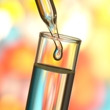
More and more patients are asking which products they should use for reducing wrinkles and sun spots. This is a particularly hot topic in the natural medicines’ world where “natural” skincare products often come with a hefty price tag. Make sure patients are putting their money towards ingredients that actually help.
Alpha hydroxy acids (AHAs) are a great place to start. There’s a fair amount of evidence that they work. Research shows that applying creams, peels or lotions containing AHAs reduces wrinkles and other signs of aging such as sun spots. They seem to work by removing the top layers of dead skin cells and increasing the thickness of deeper layers of skin. And they’re likely safe for most people when applied at a concentration of 10% or less. If patients want to give AHAs a try, make sure they also use sunscreen – AHAs can increase sun sensitivity.
Patients might also ask about topical vitamin C products. While some of these products might be expensive, there is some evidence that vitamin C helps. Research shows that applying topical products containing 3% vitamin C might reduce the appearance of wrinkles on the face after 12 weeks. Microneedle patches containing 5.6% vitamin C also seem to help with the appearance of crow’s feet by the eyes. Beyond some tingling and irritation, there isn’t any reason to expect side effects from these products.
You might also hear about hyaluronic acid. There’s some confusion surrounding this ingredient because there are various ways to administer it. Hyaluronic acid as an injectable gel filler (Juvedérm) is approved by the FDA as a medical device for correcting moderate to severe facial wrinkles and folds – but it can only be administered by a healthcare professional. Oral hyaluronic acid dietary supplements are also available. But hyaluronic acid has only been studied in combination products, so it’s not clear if taking it by mouth has any beneficial effects for aging skin. Lastly, topical hyaluronic acid products are exploding on the anti-aging market. These are the types of products you’ll likely get the most questions about – and they aren’t cheap. Despite huge marketing campaigns pushing these products, there’s no strong evidence that they help. Until supportive evidence emerges, tell patients they’re better off saving their money.
The appetite for anti-aging products isn’t going away. Do your best to point patients toward products that contain ingredients with supportive evidence, like AHAs and vitamin C. You should also steer patients toward topical OTC and Rx retinoids – they’re the best bet to help minimize fine lines. And remind patients to use a daily sunscreen, drink lots of water, and keep the skin moisturized. But tell patients not to waste their money on trendy ingredients with no supportive evidence, such as topical CBD and collagen. While there isn’t any reason to expect any safety concerns, there’s no evidence that applying these ingredients topically will have anti-aging effects.
Related topics:
The information in this brief report is intended for informational purposes only, and is meant to help users better understand health concerns. This information should not be interpreted as specific medical advice. Users should consult with a qualified healthcare provider for specific questions regarding therapies, diagnosis and/or health conditions, prior to making therapeutic decisions. Copyright © 2024 NatMed. Commercial distribution or reproduction prohibited. NatMed is the leading provider of high-quality, evidence-based, clinically-relevant information on natural medicine, dietary supplements, herbs, vitamins, minerals, functional foods, diets, complementary practices, CAM modalities, exercises and medical conditions. Monograph sections include interactions with herbs, drugs, foods and labs, contraindications, depletions, dosing, toxicology, adverse effects, pregnancy and lactation data, synonyms, safety and effectiveness.
